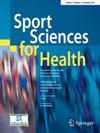最大冲刺跑步时关节工作的推进分数
IF 1.3
Q3 SPORT SCIENCES
引用次数: 0
摘要
摘要目的本研究的目的是确定在最大冲刺跑步时,踝关节、膝关节或髋关节中哪一个对水平速度最重要。此外,还对三个关节产生的推进功率和功的比例进行了量化。方法以7名国家级运动员为研究对象。4台摄像机(240 f/s)和一个内嵌式测力平台记录每个受试者的一个跑步周期。计算了三维逆动力学以及关节力矩与角速度之间的夹角,以表示推进功率和推进关节功。结果以往的研究表明髋关节是最重要的关节,但由于髋关节的个体间差异较大,本研究结果无法证实。所有受试者的平均水平显示,64%的正常阳性踝关节活动和71%的膝关节活动为推进性活动,而髋关节活动中,4名运动员为0%,1名运动员为8%,2名运动员分别为96%和97%的推进性活动。对于整个腿,推进分数为总功的70%(范围40-87%)。归一化推进功与最大跑速显著相关。结论全腿应被视为一个功能单元,其中一个或多个关节可能主导关节推进功的产生。本文章由计算机程序翻译,如有差异,请以英文原文为准。
Propulsive fractions of joint work during maximal sprint running
Abstract Purpose The purpose of the study was to determine which of the ankle, knee or hip joint is the most important contributor to horizontal velocity during maximal sprint running. Furthermore, it was undertaken to quantify the fraction of propulsive power and work produced at each of the three joints. Methods Seven athletes of national class served as subjects for the study. One running cycle of each subject was recorded by four video cameras (240 f/s) and a recessed force platform. Inverse dynamics in 3D was calculated as well as an angle between joint moment and angular velocity to express propulsive power and propulsive joint work. Results Previous studies indicating the hip joint being the most important joint could not be confirmed by the present results due to large inter-individual differences for the hip joint. Averaged across all subjects, 64% of the normalized positive ankle joint work and 71% of the knee joint work were propulsive, while for the hip joint, four athletes showed 0%, one athlete 8%, and two athletes 96% and 97% propulsive work, respectively. For the whole leg, the propulsive fraction was 70% of the total positive work (range 40–87%). Normalized propulsive work was significantly correlated with maximal running velocity. Conclusion The whole leg should be considered as one functional unit in which one or more of the joints may dominate generation of propulsive joint work.
求助全文
通过发布文献求助,成功后即可免费获取论文全文。
去求助
来源期刊

Sport Sciences for Health
Medicine-Orthopedics and Sports Medicine
CiteScore
2.60
自引率
13.30%
发文量
144
期刊介绍:
Sport Sciences for Health is an international, interdisciplinary journal devoted to researchers and practitioners involved in sport and physical activity for health. The journal deals with the mechanisms through which exercise can prevent or treat chronic degenerative disease contributing to prevention and personalized treatment of specific diseases and health maintenance with a translational perspective. It publishes original research, case studies and reviews. Areas of interest include sport, physical activities, sports medicine, healthy lifestyles, motor behavior, physical education and adapted physical activity with different methodological approaches such as physiological, clinical, biomechanical, performance, psychological, educational, social and learning perspectives. Sport Sciences for Health is the official journal of the Società Italiana delle Scienze Motorie e Sportive (SISMeS), an Italian scientific society that aims to promote, support and disseminate knowledge and innovations in the sciences of sport and physical activity for health and quality of life.
 求助内容:
求助内容: 应助结果提醒方式:
应助结果提醒方式:


